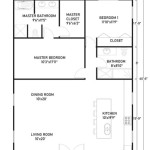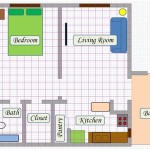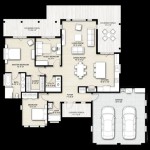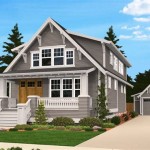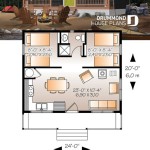One Story House Plans With Inlaw Suite: Considerations and Design Options
The increasing demand for multi-generational living has fueled interest in single-story house plans incorporating an in-law suite. These designs offer a self-contained living space within the main residence, providing privacy and independence for family members while maintaining proximity and shared resources. Effective planning is crucial to ensure the in-law suite meets the specific needs of its occupants and integrates seamlessly with the overall design of the home.
Numerous advantages are associated with incorporating an in-law suite into a single-story home. These include providing accommodation for aging parents, creating a separate living space for adult children, and offering the potential for rental income. The single-story design further enhances accessibility for individuals with mobility limitations, making it a practical and comfortable living solution for all occupants.
Key Considerations in Designing a One Story House Plan with In-Law Suite
Before delving into specific design options, several fundamental aspects must be considered to ensure the success of a one-story house plan with an in-law suite. These considerations encompass accessibility, privacy, functionality, and compliance with local building codes.
Accessibility: Given that in-law suites are often intended for elderly or disabled family members, accessibility is paramount. This includes features such as wide doorways and hallways to accommodate wheelchairs or walkers, grab bars in bathrooms, and lever-style door handles for ease of use. Ramps should be considered instead of steps at entry points, and non-slip flooring is essential throughout the suite.
Privacy: Maintaining a sense of independence is crucial for the occupants of the in-law suite. Therefore, the design should incorporate features that maximize privacy. This includes a separate entrance to the suite, allowing residents to come and go without disturbing the main household. Soundproofing the walls between the suite and the main house is also highly recommended to minimize noise transmission. Strategic placement of windows and landscaping can further enhance privacy.
Functionality: The in-law suite should function as a self-contained living space, offering all the essential amenities required for comfortable living. This typically includes a bedroom, bathroom, living area, and kitchenette. The kitchenette should be equipped with a sink, refrigerator, microwave, and potentially a small cooktop or induction burner. Adequate storage space is also essential for personal belongings and kitchen supplies. Careful consideration should be given to the layout of the suite to ensure efficient use of space and ease of movement.
Building Codes and Regulations: Compliance with local building codes and regulations is non-negotiable. These codes often dictate minimum square footage requirements for habitable spaces, as well as specific requirements for fire safety, ventilation, and electrical wiring. It is essential to consult with a qualified architect or building contractor to ensure that the in-law suite meets all applicable codes and regulations.
Layout Options for One Story House Plans with In-Law Suite
Several layout options can be employed when designing a one-story house plan with an in-law suite. These options vary in terms of their level of integration with the main house and their impact on the overall footprint of the structure.
Attached Suite with Separate Entrance: This is arguably the most common and preferred layout. The in-law suite is attached to the main house but features its own private entrance, allowing for independent access. The suite can be located on one side of the house or at the rear, depending on the orientation of the property and the desired level of privacy. Interior access to the main house can be incorporated if desired, but is not essential. This layout offers a good balance between independence and connection.
Suite at Opposite End of the House: Placing the in-law suite at the opposite end of the house provides maximum separation and privacy. This layout typically involves a longer, more elongated footprint for the house. A common living area or kitchen can serve as a buffer zone between the main living area and the suite. This option may require additional plumbing and electrical work to extend services to the far end of the house.
Suite Above a Garage or Carport: While technically not a single-story design in its entirety, a suite located above a detached garage or carport offers a unique solution for creating a separate living space. This option can be particularly appealing on smaller lots where space is limited. Access to the suite would typically be via an exterior staircase. This approach requires careful consideration of structural integrity and noise insulation.
Internal Suite with Shared Entrance: This layout involves incorporating the in-law suite into the existing footprint of the house, typically at the rear or side. The suite may share a common entrance with the main house, but it should have its own distinct living spaces and amenities. This option may be suitable for smaller homes or existing structures where adding a separate entrance is not feasible. However, it offers the least amount of privacy compared to other layouts.
Specific Design Elements to Emphasize in an In-Law Suite
Beyond the general layout, specific design elements can significantly enhance the comfort and functionality of an in-law suite, ensuring it meets the needs of its occupants.
Kitchenette Design: The kitchenette should be designed with functionality and efficiency in mind. Compact appliances, such as a microwave, refrigerator, and induction cooktop, are ideal for saving space. Ample counter space is essential for food preparation, and sufficient storage should be provided for dishes, utensils, and cookware. Consider incorporating features such as pull-out shelves and lazy Susans to maximize storage capacity. The height of the countertops and sink should be chosen to accommodate the user's needs, particularly if they have mobility limitations.
Bathroom Design: The bathroom should be designed with accessibility and safety in mind. A walk-in shower with a low threshold is preferable to a traditional bathtub, as it eliminates the risk of tripping. Grab bars should be installed near the toilet and shower to provide support and stability. A comfort-height toilet is also recommended for ease of use. Ample space should be allocated around the toilet and shower to allow for wheelchair maneuverability, if necessary. Non-slip flooring is essential to prevent falls.
Lighting and Ventilation: Adequate lighting and ventilation are crucial for creating a comfortable and healthy living environment. Natural light should be maximized through the use of large windows and skylights. Artificial lighting should be strategically placed to provide sufficient illumination for tasks such as reading, cooking, and grooming. Ventilation is essential for removing moisture and odors. A bathroom exhaust fan is a must, and consideration should be given to installing a whole-house ventilation system to improve air quality throughout the in-law suite.
Storage Solutions: Ample storage space is essential for keeping the in-law suite organized and clutter-free. Built-in closets and shelving units can maximize storage capacity. Consider incorporating features such as adjustable shelves and pull-out drawers to customize the storage space to the user's needs. Additional storage can be provided in the form of under-bed storage containers or storage benches.
Soundproofing: Soundproofing is a critical element to ensure privacy and tranquility within the in-law suite. Soundproofing materials can be incorporated into the walls, floors, and ceilings to minimize noise transmission. Insulating the walls with dense materials such as rockwool or fiberglass insulation can significantly reduce sound transmission. Installing solid-core doors with tight seals can also help to block out noise. Double-paned windows can further enhance sound insulation.
Universal Design Principles: Incorporating universal design principles throughout the in-law suite will make it more accessible and comfortable for people of all ages and abilities. Universal design features include wider doorways, lever-style door handles, rocker light switches, and adjustable-height countertops. These features enhance the usability of the space for everyone, regardless of their physical capabilities.
Furthermore, the specific needs of the occupants, such as medical equipment and specialized furniture, should be considered during the design phase. Consulting with an occupational therapist can provide valuable insights into adapting the in-law suite to meet the unique needs of its residents. Integrating sustainable design principles, such as energy-efficient appliances and water-saving fixtures, can also enhance the overall value and comfort of the in-law suite. Thoughtful planning and attention to detail are essential for creating a functional, comfortable, and private living space that meets the needs of all occupants.

House Plan 65862 Tuscan Style With 2091 Sq Ft 3 Bed 2 Bath 1

In Law Suite Plans Give Mom Space And Keep Yours The House Designers

Southern Style House Plan With In Law Suite

Impressive Home Plans With Inlaw Suites 8 House In Law Suite Floor Modular One Story Multigenerational

One Story With In Law Suite Plan 2286

House Plans With In Law Suites Houseplans Blog Com

Modern Farmhouse Plan With In Law Suite 70607mk Architectural Designs House Plans

Front Side View House Plans With A Separate In Law Suite

Pin On Dream Home

Exquisite Mountain Modern Home Plan With In Law Suite And 4 Car Garage 95104rw Architectural Designs House Plans


